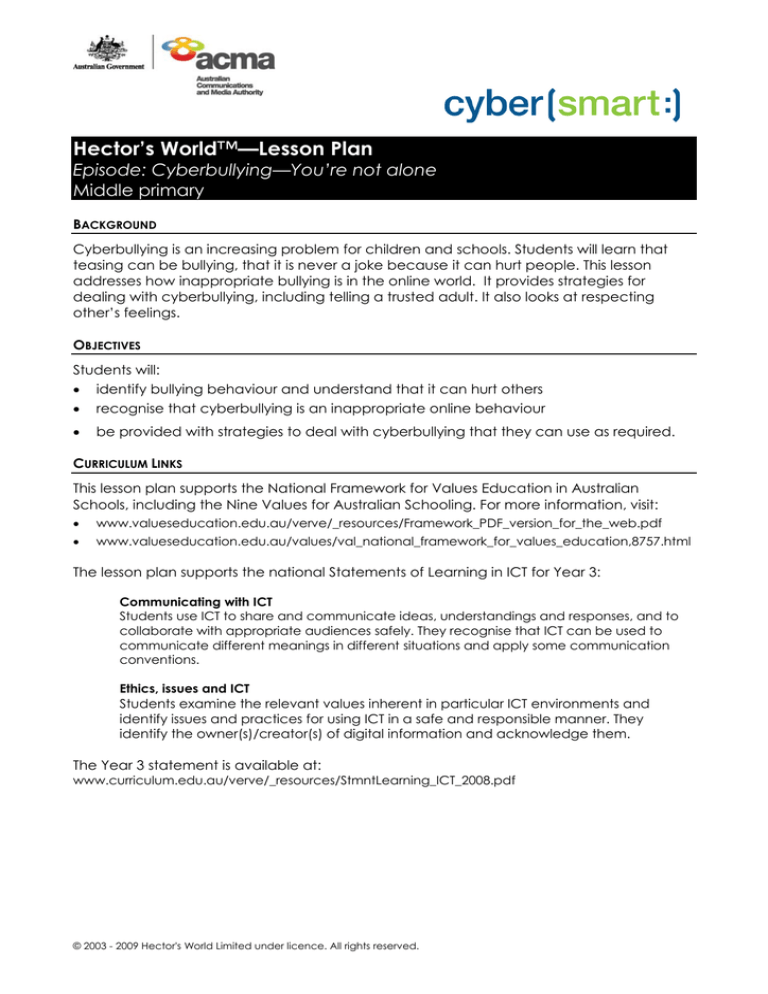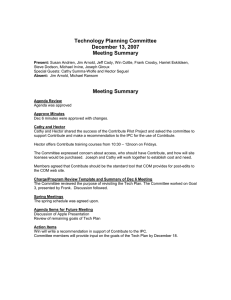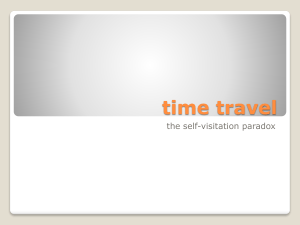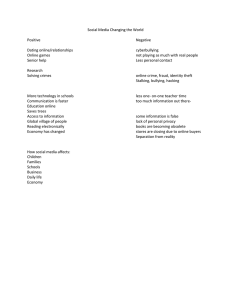
Hector’s World™—Lesson Plan
Episode: Cyberbullying—You’re not alone
Middle primary
BACKGROUND
Cyberbullying is an increasing problem for children and schools. Students will learn that
teasing can be bullying, that it is never a joke because it can hurt people. This lesson
addresses how inappropriate bullying is in the online world. It provides strategies for
dealing with cyberbullying, including telling a trusted adult. It also looks at respecting
other’s feelings.
OBJECTIVES
Students will:
•
identify bullying behaviour and understand that it can hurt others
•
recognise that cyberbullying is an inappropriate online behaviour
•
be provided with strategies to deal with cyberbullying that they can use as required.
CURRICULUM LINKS
This lesson plan supports the National Framework for Values Education in Australian
Schools, including the Nine Values for Australian Schooling. For more information, visit:
•
www.valueseducation.edu.au/verve/_resources/Framework_PDF_version_for_the_web.pdf
•
www.valueseducation.edu.au/values/val_national_framework_for_values_education,8757.html
The lesson plan supports the national Statements of Learning in ICT for Year 3:
Communicating with ICT
Students use ICT to share and communicate ideas, understandings and responses, and to
collaborate with appropriate audiences safely. They recognise that ICT can be used to
communicate different meanings in different situations and apply some communication
conventions.
Ethics, issues and ICT
Students examine the relevant values inherent in particular ICT environments and
identify issues and practices for using ICT in a safe and responsible manner. They
identify the owner(s)/creator(s) of digital information and acknowledge them.
The Year 3 statement is available at:
www.curriculum.edu.au/verve/_resources/StmntLearning_ICT_2008.pdf
© 2003 - 2009 Hector's World Limited under licence. All rights reserved.
Cross curriculum links
This lesson plan can be used in any of the following subjects and topic areas:
• identity
•
health
•
communication
•
•
SOSE
the arts
•
personal development.
Teacher’s
Hints
SUGGESTED LESSON PROGRESSION
Although this lesson may stand alone, it is preferable that students have
already been introduced to Hector’s World—or that the lesson is used within
the context of a unit on Hector’s World and online safety. This lesson involves
identifying some of the characters’ trait. This will be easier for students if they
have viewed previous episodes. Episode1 : Details Details… provides a good
introduction to the characters.
Introduce the animation to the class by asking who is familiar with Hector’s World. Allow
students to share some of their previous knowledge.
Explain, for anyone who is not familiar with the resource, that Hector and his friends live
under the sea in Silicon Deep. They have lots of technology, like computers and mobile
phones, because a cargo ship that was carrying the items sank. Now they are all learning
about how to use these ‘sunken treasures’ safely.
Ask students the question, ‘This episode is about cyberbullying. Does anyone know what
that is?’
Briefly acquaint students with the term ‘cyberbullying’ through a short discussion. Only a
basic understanding of the term is required and should cover these points:
• cyberbullying uses technology such as mobile phones and the internet
•
like other forms of bullying, it hurts the feelings of others.
Explain that in this episode, one of the friends is cyberbullied. They need help to sort out
the problem.
ACTIVITY
1. View the animation
Start the animation, Cyberbullying—You’re not alone.
A pause point symbol will appear in the episode in the lower right corner, three seconds
before the point to stop the video.
© 2003 - 2009 Hector's World Limited under licence. All rights reserved.
Pause Point 1
At the first pause point, stop the animation and allow students time to digest the question
and share some ideas. There are three primary questions for discussion at this first pause
point. The discussion could be preceded by a short explanation of ‘altering’ or ‘morphing’
a photo.
Ask the students:
•
How would Ming feel about the altered photo that made fun of her?
•
How would Ming feel about that photo being sent to many other people?
•
What could Hector and his friends do to help Ming?
Some additional questions to ask:
•
Why do you think Brooke and Bella sent the messages in the first place?
•
Is it a good joke to play? Why not?
Resume the animation.
Pause Point 2
At the second pause point, stop the animation and again allow students time to digest
the question and share some ideas.
Ask the students:
•
What would you suggest Ming do?
This time, direct the discussion towards advising a victim of cyberbullying to seek
assistance. Ideally, Ming, being a child, should seek help from a parent, or other trusted
adult.
Conclusion of the animation
Immediately following the animation, briefly recap the episode with the students to check
their understanding.
Gather students into small groups and distribute scene cards (attached), one to each
group. These cards show the following:
• Brooke and Bella thinking about what they did
•
The friends happy when Ming returns to the group
•
Brooke and Bella when they saw Ming’s reaction to the first message
•
•
Hector when Ming ignores him
Sprat when he sees the message
•
Tama when he sees Brooke and Bella laughing
•
Hector when he is asking for help from the audience
•
Ming crying in her room.
Ask the group to take one minute to write down three words which describe how the
character is feeling in each picture. After one minute, groups should exchange cards with
another group and so on until each group has had each card. Each group keeps the
same piece of paper for recording their answers throughout the exercise.
© 2003 - 2009 Hector's World Limited under licence. All rights reserved.
2. Review learning
Groups report back to the class the words they came up with for each scene. This could
be done on a whiteboard, using a digital projector, or on large sheets of paper.
3. Consolidate learning
Distribute the cloze cyberbullying worksheets (attached). Students complete the sheets
individually where possible. Use the words on the board to complete the sentences.
EXTENSION ACTIVITIES FOR ALL AGE GROUPS
The following are suggested activities that can be used to further extend students’
understanding of cyberbullying. These are for all age groups so they can be modified to
suit individual classes.
Some of these activities use Hector’s World resources from other episode lesson plans.
These are available on the Hector’s World pages at www.cybersmart.gov.au
1. A discussion of ‘assets’
In the episode, Ming is shown as generally very confident, with supportive friends and a
responsive parent. Not all children are so fortunate.
Lower and middle primary
Discuss the following topics with students, and demonstrate and display strategies for the
students to follow.
Actions to take in instances of bullying:
•
Tell an adult.
•
•
Talk to a friend.
If a friend talks to you about bullying, take them to tell an adult.
Look at being part of a supportive peer group. Discuss:
•
How to join in with a group.
•
•
How to spot someone feeling left out (body language, sitting alone, looking sad etc.)
How to ask someone if they need help.
•
How to support someone being bullied.
Middle and upper primary
Make a list of Ming’s assets—the advantages/support she has—and talk about things
children who don’t have those advantages could do. For example, if the first trusted adult
a child tells about the bullying does not recognise the seriousness of the problem, what
can the child do? Or, if the child is new to the school and doesn’t have a network of
friends yet, what can they do?
© 2003 - 2009 Hector's World Limited under licence. All rights reserved.
2. Photos and photo netiquette
Images of ourselves are very personal. Discuss with students if it is okay to take a photo of
someone without their permission. Is it also okay to alter that picture without their
permission? What happens to a photo once it is sent? Can it be retrieved?
Lower and middle primary
Encourage students to focus on accentuating the positive aspects of photography. Bring
a favourite family photo to school and discuss why it is special.
Ask the group:
• Why do we take photos?
•
What special occasions do we take photos of? For example: holidays, parties and
family gatherings
•
•
How do we feel when having our photo taken?
Do we always enjoy having our photo taken?
•
Who do we share our photos with?
•
Why do we say cheese?
Create a class display of their favourite photos or take some with the class digital camera
under the heading ‘Photos are for…’. Include some of the key words from the previous
discussion, for example: holidays, good memories, family times and friends.
Middle and upper primary
List strategies for being responsible with a digital camera including ones for mobile phone
use. Emphasise the importance of getting a parent or teacher’s permission before sending
or posting personal images.
A ‘Digital photo Ps and Qs’ or ‘Guide to photo courtesy/photo netiquette’ could be
displayed on the classroom wall. This idea could be introduced across the school as a
student initiative to encourage responsible use of digital images by everyone.
If the school has a consent process for publishing student images or details online, the
class could discuss this process by thinking about what scenarios the process might cover,
whether they themselves are involved in the process, and why there is a process in the first
place.
3. Music, video and song
All resources described in the lesson plans are available on the Hector’s World pages at
www.cybersmart.gov.au.
Play the music video Cyberbullying: Turn It Around to introduce the class to the music and
lyrics.
Discuss the feelings the class had about the song and lyrics.
Supply each student with a printed song sheet and go over the words of the song until
everyone is confident.
© 2003 - 2009 Hector's World Limited under licence. All rights reserved.
Sing along with the class to the MP3 file of the song.
Other ideas
•
In groups, work out movements to the song.
•
Teach the song to another class. This teaching could cascade across the school
until all students can sing the song together. That is, the first class to learn the song
teaches to the next. Each class teaches another until the whole school knows the
song and can sing it together.
© 2003 - 2009 Hector's World Limited under licence. All rights reserved.
Cyberbullying worksheet
Cyberbullying is when technology, like the internet or a mobile phone,
is used to make someone feel __________.
Some jokes are funny, but teasing and making someone feel
__________ is not a joke.
When Hector saw that Ming was sad he felt __________.
Constable Solosolave said that we should never stand by and let
__________ things happen to people in our community.
Ming’s friends were __________ when she re-joined them at Digital
Citizens’ Day.
When Brooke and Bella realised that what they did was wrong they
said they were really __________.
The friends learned it is not okay to tease someone even if it is just a
__________.
Ming learned that talking to someone about a problem will make you
feel __________.
Draw a picture
of Silicon Deep!
© 2003 - 2009 Hector's World Limited under licence. All rights reserved.
© 2003 - 2009 Hector's World Limited under licence. All rights reserved.
© 2003 - 2009 Hector's World Limited under licence. All rights reserved.
© 2003 - 2009 Hector's World Limited under licence. All rights reserved.
© 2003 - 2009 Hector's World Limited under licence. All rights reserved.




